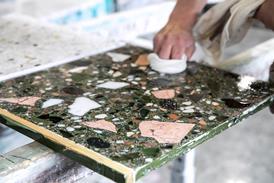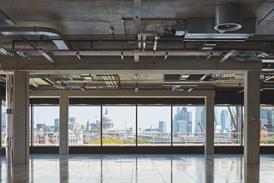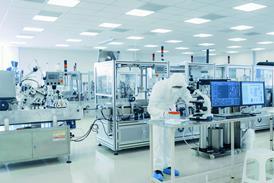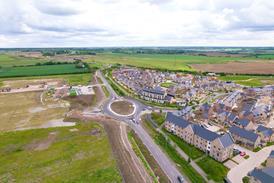Sustainability isn’t always about renewables. Hoare Lea gave the University of Glamorgan the traditional eco treatment.
With its sleek, glass atrium, dynamic open-plan interior and sculptured spiral staircase, Cardiff’s new £35 m School of Creative and Cultural Studies is contemporary, edgy and artistic, reflecting the building’s creative function.
So, all the more reason to take a modern approach when it comes to sustainability, you might think. A few wind turbines here, the odd strategically placed photovoltaic panel there, perhaps even a ground-source heat pump?
“We’ve used traditional systems mostly,” says Hoare Lea project manager Ken Briggs, somewhat surprisingly. “We had to use the available, tried and tested technology to achieve best practice energy targets without using renewable technology, which the stringent budget simply wouldn’t stretch to.
“People these days can get too hung up on putting renewables in, even if they can’t afford it. You don’t always need to. A lot can be achieved through good design, improving your U values and a decent room-by-room control system.”
Designed by Holder Mathias Architects, the new development goes by the name of Atrium. The project involved the refashioning of a 70 000 ft2 former BT building, which was gutted to its bare steel, together with a bespoke, modernist 40 000 ft2 extension. The two are linked by a five-storey atrium thoroughfare.
The project was commissioned by the University of Glamorgan. The new facility offers state-of-the-art performance and rehearsal spaces, together with high-tech broadcasting, recording and design for a variety of creative specialities including music, drama, TV and radio, fashion, graphics and architecture.
Hoare Lea set to work on the m&e design with a budget of £5 million back in July 2006. It used 3D-modelling to ensure all plans satisfied both the Building Regulations and the architect.
The team quickly discovered that there were technical as well as economic reasons why they couldn’t opt for certain renewable technologies.
“We couldn’t have, say, ground-source heat pumps installed because, with the existing structure being a BT building, the ground was peppered with major telephone lines,” explains Briggs.
The 16-month fast-track project called for a dedicated site-meeting strategy. Regular co-operation between the design team and contractors was crucial. Hoare Lea attended fortnightly project meetings with main contractor Willmott Dixon Turner, electrical installer Evans Electrical and CMB Engineering, which did the mechanical fit-out.
Briggs himself was on site for at least two days a week.
“I did more site visits than I’ve ever done before because it was such a tight programme,” he says. “But one of the main lessons I’d pass on lies in highlighting the importance of co-operation and co-ordination. We were in at the very start, and we were able to input into the actual design and the thermal modelling. Everyone was pulling in the same direction.”
Crucially, the team also adopted a philosophy of nil defects.
“People usually snag it at the end of the job, but we were closely inspecting it for defects all along,” says Briggs. “It worked really well because it speeded up the handover process.”
Hoare Lea’s back-to-basics approach to energy efficiency centres around a comprehensive, fully integrated building management system by Honeywell Controls costing around £400 000.
To achieve maximum energy control, each room was assigned separate auto control for heating and air handling. This was particularly crucial for the university building’s decidedly varied functionality.
“Each area has been broken down and is serviced in individual zones, as they’ve all got different needs and time usages. The official opening hours are 8am until 10pm, but there are certain areas that need to be open all the time and still others that will get far less use. You don’t want to heat the entire building, or have the lighting on all the time in areas where it’s not required.”
High-efficiency lighting controlled by PIR and daylight linking was installed throughout. Specialist areas such as the theatre, cinema and TV studio benefit from lighting which is user-controlled via individual control rooms incorporated within each space.
“What we did was drill down as far as we could with the control elements to optimise use of energy,” says Briggs.
It may not be the sexiest approach to reducing one’s carbon footprint, but inverter-driven fans and pump motors, which have been fitted throughout the building, are a failsafe method of optimising energy use. As systems close down under thermostatic control, motors ramp down accordingly.
Other methods have also worked out well. The building runs on high-efficiency, gas-fired condensing boilers and hot-water heaters that use low levels of mono-nitrogen oxides (NOx). High-efficiency thermal wheels within the multi-zoned air-handling plant result in 85% efficiency, and CO2 control has been put in place in the cinema and theatre.
Briggs is enthusiastic about the results. “It’s an excellent building and an inspirational one, especially for the students themselves.”
Hoare Lea was also responsible for the acoustics.
“The Atrium was built right next to a railway line, and because we have recording studios that are almost BBC standard, the acoustic requirements were very stringent. We had to make sure the insulation was of a high standard, which also cut the U-values by 50%. That was of benefit to our overall sustainable approach, too.”
The development benefits from mixed-mode ventilation. User control, such as the opening of windows, was not an option in all areas, especially auditorium and studio spaces.
“The acoustics are crucial within these rooms,” stresses Briggs. “The old BT building is used for admin and is mixed-mode, but the new-build, creative wing has to be fully mechanical.”
Measuring energy consumption and ensuring facilities operators are able to do the same is a basic first step within any project that has a sustainability focus. Version 5.6.1 of IES’ thermal modelling software was employed by Hoare Lea’s Virtual Engineering Group in order to study U-values and make the best possible savings. It seems to have paid off.
“Under the Building Regulations you have to achieve a 27% improvement over the 2002 objectives. We’ve achieved 42%,” says Briggs.
Energy use at the Atrium is monitored via pulsed outputs from multiple electrical meters, water meters and gas meters.
“The client has real-time access to graphic displays at any time in order to check how the building is performing. Any out-of-limit usage can be seen immediately, investigated and corrected if necessary,” says Briggs.
Although the client has taken on a facilities management team of its own, Hoare Lea will be helping out with areas such as energy monitoring for the first year or so. The ongoing agreement will help the development achieve its predicted ‘good practice’ benchmarks.
“With all the temperature and time settings, it’s the university’s most complex building, so we’re making sure its facilities management people understand how they can adjust the building management system to their needs,” says Briggs.
“We always try to maintain close contact with the client after completion. We don’t just leave them to it.”
All in all, the Atrium development seems set to be a big success. So, what advice does Briggs have for those working with poor students?
“With renewables, the payback is not always there and can, on occasion, be a very big capital outlay for the client. There is another way: think differently.”
Profile
Players
Project: Cardiff School of Creative and Cultural Industries (Atrium)
Client: University of Glamorgan
Project manager and QS: Davis Langdon
Architect: Holder Mathias Architects
Structural engineer: Arup
M&E consulting engineer: Hoare Lea
Lighting designer: Hoare Lea
Management contractor: Willmott Dixon Turner
Electrical contractor: Evans Electrical
Mechanical contractor: CMB Engineering
Refrigeration subcontractor (existing building): JCW Air Conditioning (Wales)
Refrigeration subcontractor (new-build): MacWhirter
Contract details
Tender date: March 2006
Form of contract: JCT Management Form of Contract 1998
Contract period: 16 months
Providers
Mechanical suppliers
AHUs: Systemair
Boilers: Hamworthy
Chilled ceiling: Price Technical
Chillers: Carrier
Control valves: Honeywell
Coolant: Chilled water and R403A refrigerant
Condensers: Searle
Computer room a/c: Daikin
Drainage (above ground): Saint-Gobain & Geberit
Ductwork: Venteck
DX systems (VRV): Daikin
Extract fans: Systemair
Fan coil units: Biddle
Flues: Selkirk
Gas boosters: Dunphy Combustion
Humidifiers: JS Humidifiers and Vapac Humidity Controls
Perimeter heating: HCP
Pumps: Grundfos
Pressurisation: Engineering Appliances
Radiant panels: Solray
Radiators: Merriott and Hudevad
Sound attenuation: Allaway Acoustics
Underfloor heating: Warmafloor
Water heaters: Andrews
Electrical suppliers
BMS: Honeywell
CCTV: Bosch
Cable: Delta Crompton
Cable management: MK/Flexicon/Barton
Controls: Telemecanique
Electrical distribution: Eaton (MEM)
Electrical accessories: Deta & MK
Emergency luminaires: Thorn
Lightning protection: Furse
Fire alarm/detection: Initial
Floor boxes: Ackerman
Lighting controls: Ex-Or
Luminaires: Thorn
LV switchgear: Dorman Smith
Power busbar: Telemecanique
Public address: Initial
Security equipment: Bosch
Trace heating: Jimmy Heat
UPS: Socomec
Voice and data equipment: Cablecom
Water leakage detection: Kidde
Prices
Total cost: £35 m
Mechanical services cost: £2.8 m
Electrical services cost: £2.2 m
Source
Electrical and Mechanical Contractor





















No comments yet